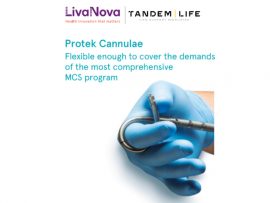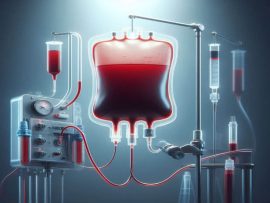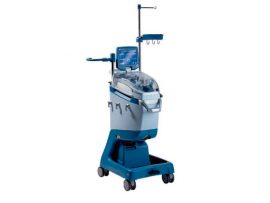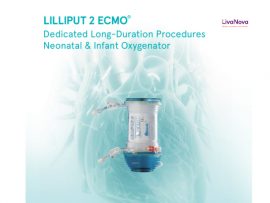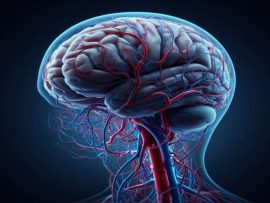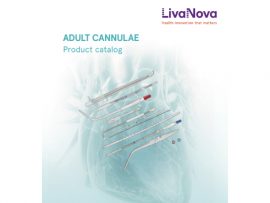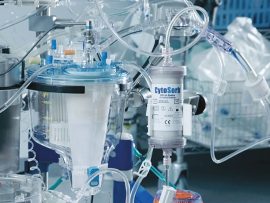Abstract Background Despite sternum sparing and without cardiopulmonary bypass, the actual value of minimally invasive coronary surgery (MICS) is still debatable. This study aimed to compare the completeness of revascularization..
Lee masAbstract Objective To evaluate the effectiveness of venovenous (VV) extracorporeal membrane oxygenation (ECMO) using a dual-lumen cannula coupled with continuous mechanical chest compressions (cMCC) for cardiopulmonary resuscitation and compare it..
Lee masAbstract Objective To determine if the route of administration of whole blood cardioplegia (cardioplegia) is significantly associated with the frequency of profound transient hypotension (intermittent “vasoplegia”) often observed during cardioplegia..
Lee masAbstract For patients undergoing extracorporeal membrane oxygenation (ECMO), clot formation is a critical complication requiring high-risk circuit changes. Blood tests used to assess clotting risk may be drawn only four..
Lee masAbstract Objectives Evaluating blood transfusion practices and their impact on morbidity and mortality across extracorporeal membrane oxygenation (ECMO) configurations. Background As ECMO becomes increasingly utilised in critical care, the ideal..
Lee masAbstract The correct arterial cannula size for percutaneous femoral venoarterial extracorporeal membrane oxygenation (VA-ECMO) cannulation is imperative for adequate circulatory support. We aimed to describe the relationship between cannula size,..
Lee masAbstract Objetives Extracorporeal membrane oxygenation (ECMO) after surgery for congenital heart disease (CHD) provides hemodynamic support to patients when their myocardial function is temporarily affected. Postoperative infections in children with..
Lee masAbstract Background: The use of cell salvage reduces homologous blood transfusions during operations and avoids associated complications. Therefore, autotransfusion is an integral part of Patient Blood Management (PBM). The..
Lee masAbstract Infection cases have been reported where Legionella spp. and NTM (non-tuberculous mycobacteria) increased due to the contamination of circulating water in cold/heated water supply systems for extracorporeal circulation used in cardiac..
Lee masAbstract Background Extracorporeal membrane oxygenation (ECMO) provides mechanical circulatory and respiratory support. However, thrombus formation in the circuit can lead to hemorrhagic complications, requiring improvements in ECMO anti-thrombogenicity. Few studies..
Lee masAbstract Introduction Current guidelines advise that anaphylactic shock refractory to traditional treatments may be managed with extracorporeal life support (ECLS), but reports have been exclusive to adults. Case Report We..
Lee masAbstract Background: Minimally invasive extracorporeal circulation (MiECC) has been introduced to mitigate the inflammatory response and reduce blood transfusion needs compared to conventional cardiopulmonary bypass (CPB) perioperatively. A hybrid system..
Lee masAbstract Digital ischemia following extracorporeal membrane oxygenation (ECMO) therapy is a known complication with potential devastating long-term sequela. Onabotulinum toxin type A (BTX-A) has been demonstrated to be effective for..
Lee masAbstract BACKGROUND: Current blood pressure management strategies cannot accommodate large interindividual variations in cerebral autoregulation, which may result in inadvertent cerebral ischemia. A novel optical neuromonitoring device was developed to..
Lee masAbstract BackgroundCPR-induced consciousness (CPRIC) is defined as consciousness during CPR, ranging from eye opening to combative behaviour and vocalisation, despite the absence of spontaneous circulation. CPRIC has not previously been..
Lee masAbstract Introduction: In cardiopulmonary bypass (CPB), blood circulation is temporarily maintained by an artificial blood-pumping device during cardiac surgery. Worldwide, approximately half of the CPB procedures utilize either centrifugal or..
Lee masAbstract OBJECTIVES Cardiogenic shock is still a major clinical challenge, despite the available devices. We developed a minimally invasive, transapical dual-lumened cannula, which can provide antegrade circulatory support and unloading..
Lee masAbstract Background Studies have proved that artery infusion during CPB operations can reduce lung injury led by CPB surgery. This study was undertaken to investigate the effects of HTK solution..
Lee masAbstract Introduction It is around 4 PM when the surgeon, having just transferred his afternoon theater patient to the intensive care unit (ICU), approaches the patient’s family with a reassuring..
Lee masAbstract Cardiac allotransplantation is warranted in children with end-stage heart failure or irreparable congenital heart disease. A dearth of organs for transplantation has contributed to long wait-list times and resultant..
Lee masAbstract Assisted artificial intelligence (A-AI) has rapidly become a gold standard approach for conducting data analysis and medical writing []. From executing complex statistical tasks to extracting relevant information and..
Lee masAbstract Intra-aortic balloon pump (IABP), which augments coronary blood flow and reduces cardiac afterload, is the most widely used temporary mechanical circulatory support (TMCS) device. It has been used in..
Lee masAbstract Background: Data is limited regarding the effects of supraphysiologic blood oxygen tension (hyperoxia) in patients requiring extracorporeal life support (ECLS). We sought to evaluate the association between hyperoxia and..
Lee masAbstract Introduction Increased time-dose-response (TDR) of suboptimal oxygen delivery (DO2) during cardiopulmonary bypass (CPB) has been associated with increased postoperative complications. The impact of surgical approach - minimally invasive vs...
Lee masAbstract OBJECTIVES Randomized clinical trials (RCTs) are the gold standard for comparative effectiveness. However, they face unique challenges in cardiac surgery. The objective of this work is to summarize the..
Lee masAbstract Background It is hypothesized that combining HA380 with cardiopulmonary bypass (CPB) in acute type A aortic dissection (ATAAD) surgery could reduce the inflammatory response induced by CPB and subsequently..
Lee masAbstract Background Selective antegrade cerebral perfusion, via unilateral antegrade cerebral perfusion (uACP) or bilateral antegrade cerebral perfusion (bACP) approaches, is used in aortic arch surgery to protect the brain during..
Lee masWe are getting a lot of questions about working in Europe as a Perfusionist. Each country has its own regulations, its perfusion qualification, but we always say that a great..
Lee masAbstract The human heart has one of highest metabolic requirements in the body: even in a resting physiologic state it must work to circulate approximately 5 L/min to 8 L/min..
Lee masAbstract Objectives To assess concordance between Hemochron Response (ACTr) and the three-activator device Hemochron Signature Elite (ACTe) in adult cardiac surgery patients. To evaluate the correlation between ACTe and anti-Xa..
Lee mas

